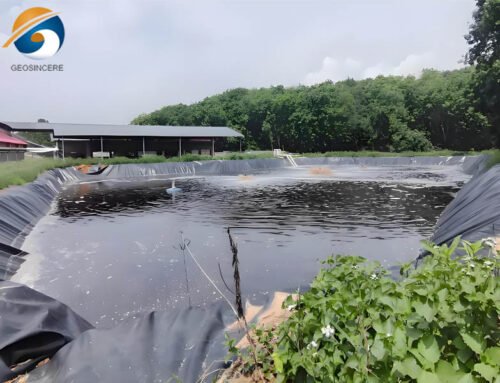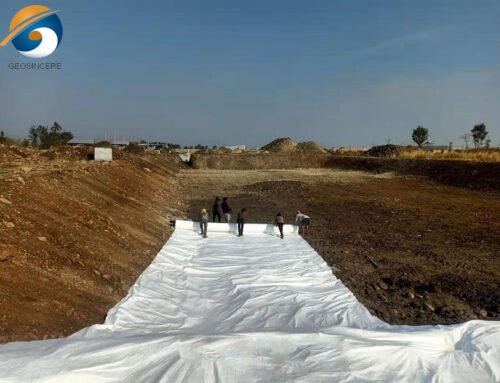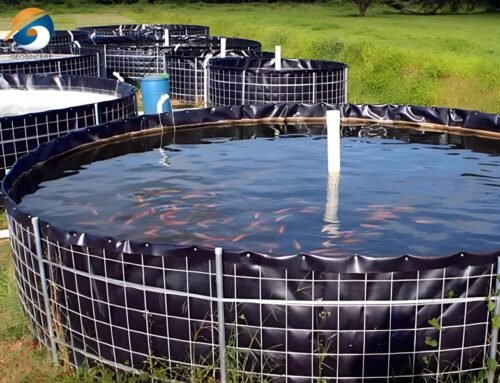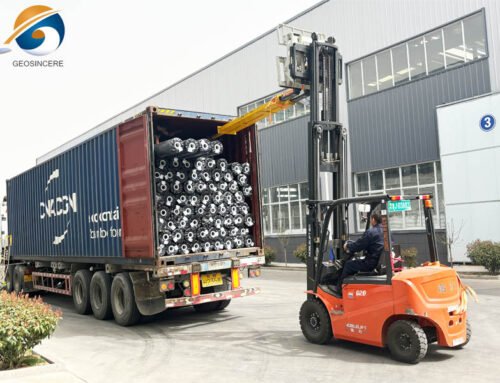A comprehensive guide to gomembrane installation, also known as how to install geomembrane, this article can be helpful for the people who want to know more about geomembrane industry. Geomembrane is the anti-seepage geotechnical material based on high molecular polymer (such as HDPE). HDPE geomembrane liner plays a vital role in various industries, providing necessary closure solutions for environmental engineering projects and construction projects, widely used in aquaculture, solid waste treatment, municipal engineering, sewage treatment, slag treatment, industrial anti-seepage, landscaping, water conservancy projects, energy industry anti-seepage and coverage and other fields. Geomembranes are generally divided into smooth HDPE geomembrane liner, textured geomembrane liner and composite geomembrane liner. According to color classification, there are black geomembranes, white geomembranes and green geomembranes. The thickness of geomembrane is from 0.5mm to 3mm, the width of geomembrane is up to 10m, the length of one roll of geomembrane can be 400 meters. This comprehensive guide to geomembrane installation aims to provide more accurate and valuable practical knowledge and guidance for Geomembrane industry customers. Followed are the steps for geomembrane installation.
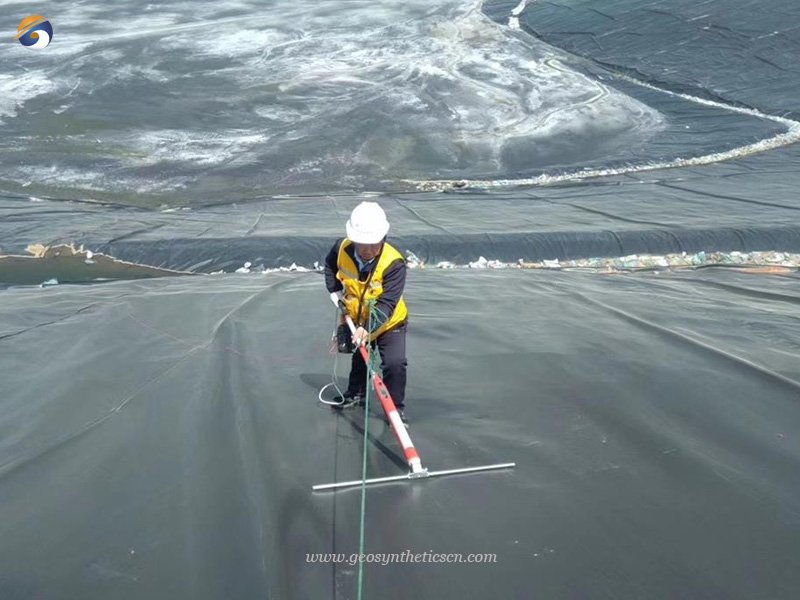

1.Preparation and Planning for Geomembrane Installation
Preparation and planning are essential before beginning the geomembrane installation process. This includes site evaluation, soil analysis and selection of the appropriate Geomembrane model for a specific application. Proper site preparation, such as clearing and leveling the ground, ensures a stable foundation for the Geomembrane system.
(1) Carefully prepare the materials, tools and safety measures required for geomembrane installation and testing; main tools include but are not limited to hot air welding torches, gas inflation detectors, geomembrane welding machines, scissors, utility knives, meter tapes, calipers, inspection rods, pliers, Screwdrivers, hammers, shovels, brooms, sandpaper, plastic woven bags, etc.; material preparations include HDPE geomembrane and welding rods, which must be checked and confirmed before construction;
(2) The project team closely cooperates to complete the installation and construction of HDPE geomembrane and other materials;
(3) Before HDPE geomembrane laying construction, the base surface must meet the design requirements, and it must be inspected and accepted according to the construction process;
(4) Various materials used in construction shall comply with design and specification requirements. Inspection should be carried out during the construction process, and records should be made in time;
(5) In the process of geomembrane installation, when cross-construction is required, it should be implemented in accordance with other current relevant engineering construction operations. Cross construction shall not affect each other;
(6) During the construction operation of anti-seepage works, special regulations on safety must be strictly followed, and personal and property safety must be ensured.
(7) Requirements before construction
① Base surface requirements
- The quality of the base surface should meet the design requirements: the bottom surface of the foundation pit, the slope surface and its slope ratio, the anchor groove on the slope, and the junction between the slope surface and the bottom surface should strictly meet the design requirements;
- The base surface should be conducive to the laying construction of HDPE geomembrane. The base surface should be dry, compacted, flat, free of cracks, sharp protrusions, and depressions, and there should be no foreign objects such as tree roots, stones, and glass shavings within a vertical depth of 25 mm. Its flatness should change gently within the allowable range, with uniform slope and consistent slope, which meets the design requirements;
- The transition between Yin and Yang on the base surface should be smooth, and its radius should not be less than 500mm;
- The base surface is dry, and the moisture content of the base surface should be below 15%;
- Before laying geomembrane and other materials every time, the treatment of the base surface to be paved must be completed, and the construction of laying geomembrane must not be affected.
② Climate requirements
- The temperature should generally be between 5 and 40 degrees Celsius, and the geomembrane should be deployed in a natural state.
- The laying should not be too tight or too loose. When the temperature is too low, the construction should not be carried out in strong winds above grade 4 and rainy and snowy days. In windy weather, when the wind affects the geomembrane construction, the HDPE geomembrane to be welded should be pressed firmly with sand bags.
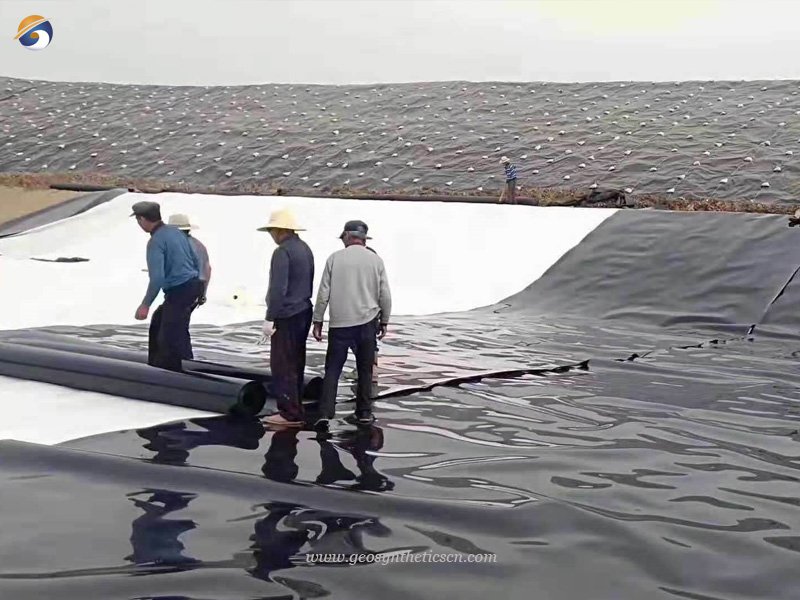

2. Geomembrane Installation Steps
The laying and welding construction of HDPE geomembrane is the key link of the whole anti-seepage project. The construction quality of the geomembrane anti-seepage layer determines the success or failure of the whole project. Buried gas collection will be greatly reduced. Therefore, in the construction, every process and every link must be strictly organized and carefully constructed. The following are the main geomembrane installation steps.
2.1 Geomembrane installation preparation
Open the package to check the appearance quality of the HDPE geomembrane, record and repair the found mechanical damage and production trauma, holes, breakage and other defects. Damaged HDPE geomembranes should not be used;
The construction of the HDP geomembrane in the previous process conforms to the design and specifications, and the geomembrane construction starts after passing the acceptance.
Geomembrane cutting and shipping. First send surveyors to accurately measure the actual terrain, record the measured dimensions in detail, and then cut them according to the plan, and transport them to the corresponding positions on the construction site in sequence.
2.2 Equipment requirements for geomembrane installation
Geomembrane welding machine must be cleaned, reset and tested before each shift or daily work, during continuous use, and when the maximum use interval exceeds 5 hours, the equipment must be cleaned, reset and tested to ensure the quality of the weld.
2.3 Laying requirements for special parts
When laying film at the slope foot, turning and slope intersection, the base surface should be smooth and smooth when turning, and no negative slope should appear. When laying the geomembrane, relax as much as possible, and the geomembrane cannot be suspended.
At the intersection of slopes, the laying and welding of HDPE geomembrane should take corresponding measures according to local conditions, so that the membrane can be more closely attached to the base.
Special treatment is also required at the slope toe where the side slope connects with the bottom of the field. The HDPE geomembrane of the slope is laid along the slope surface 500mm away from the slope foot, and then welded with the HDPE geomembrane at the bottom of the site.
2.4 Foundation preparation and leveling.
Before laying HDPE geomembrane, the laying base should be fully inspected. The laying base should be properly compacted and leveled. There should be no sundries that may damage the HDPE geomembrane within a vertical depth of 25mm. Thoroughly eliminate sharp objects or potential dangers that may affect the integrity of the Geomembrane things.
When the HDPE geomembrane is laid on the backfill foundation, the compaction of the backfill should not be less than 95%.
The laying base should be free of water seepage, silt, water collection, organic residues and harmful substances that may cause environmental pollution. The corners of the base should be smooth. Generally, the radius of the arc should not be less than 500mm.


2.5 Expand and position Geomembrane
Careful unrolling and positioning of Geomembrane rolls will be required to ensure adequate coverage and allow overlap at seams which should be left in their natural state for lay-up welding.
After the geomembrane is placed in the anchoring ditch, it is temporarily pressed firmly with sandbags. After the geomembrane is welded and adjusted properly, the geomembrane is permanently anchored with rammed clay. 2m on both sides are not anchored for the next welding. The tamped clay anchoring and geomembrane welding should be carried out crosswise, and should not overlap each other. The newly laid geomembrane should not be anchored immediately, and should be adjusted after proper adjustment. After the slope geomembrane is laid, the bottom geomembrane should be laid in time.
2.6 Welding and seaming technology
Geomembrane welding is performed using specialized equipment to create strong and leak-free seams. Commonly used techniques include thermal wedge welding, extrusion welding, or solvent welding, depending on the Geomembrane material used.
Before the welding construction, the sample welding must be carried out first, and the formal welding can only be started after the test welding is qualified. When welding, check the overlapping width of the diaphragm again, and ensure that the overlapping area is clean, free of foreign matter, and free of anything else that may affect the welding.
In plane welding, two workers are required to cooperate, one person wipes the geomembrane to be welded in front, the front personnel should not be too far away from the welding machine, keep about 1m, and the other person takes care of the welding machine and carries the power cord.
When welding on the slope, the welding machine crawls from top to bottom. The operator must always follow the operation of the welding machine under the protection of the safety belt and the rope ladder, and fine-tune the various technical parameters of the welding machine in time, in a certain order. welding. To make the whole process of the welding machine in the best working condition, to ensure the quality of the weld.
The hot wedge welding machine works automatically. Welding engineers should pay attention to emergencies when the welding machine is moving, so welding engineers should always follow the welding machine.
For parts where the hot wedge welding machine cannot work, an extrusion welding machine is used for construction. The extrusion welding machine does not crawl automatically, but keeps the welding machine moving in a certain direction evenly by hand.
Therefore, extrusion welding engineers need special training, and they can work only after they are proficient. When extrusion welding, people must press down on the extrusion welding machine to ensure the quality of the weld. To speed up the film laying speed, 2-3 hot wedge welding equipment can be used for welding at the same time.
The bottom geomembrane should relate to the geomembrane on the slope as soon as possible to prevent rainwater from pouring into the bottom of the welded geomembrane when it rains.
The laying and welding of the bottom geomembrane is carried out after the laying and welding of the slope geomembrane is completed. When laying the geomembrane, it should be welded while laying, and the welding should be completed on the same day of laying.
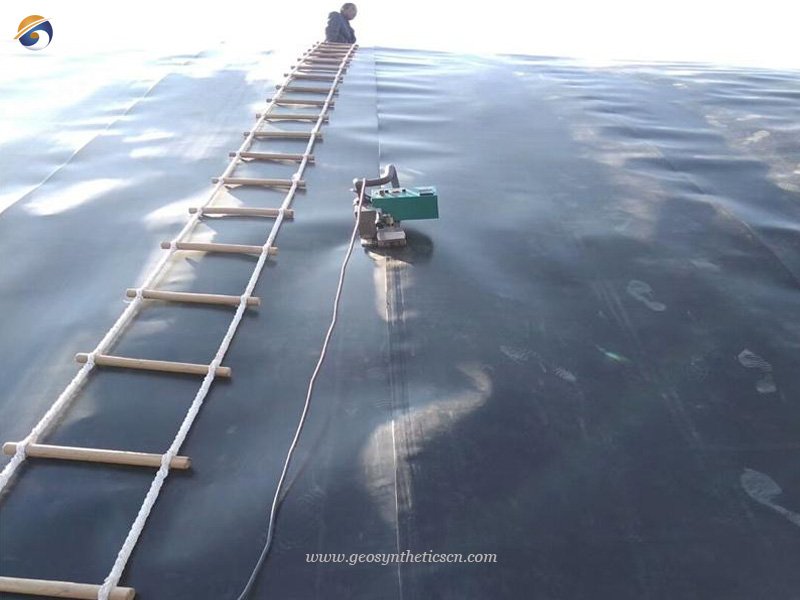
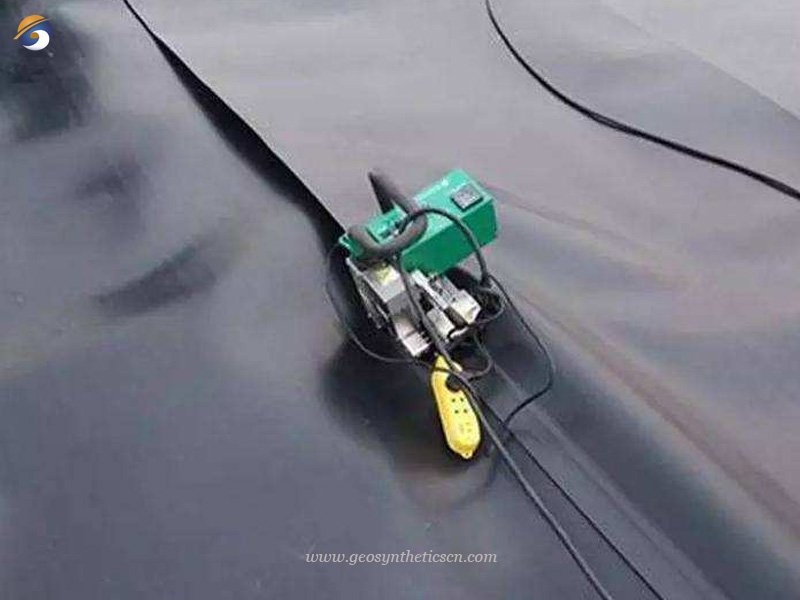
2.7 Edge processing and fixation
Proper edge handling and securing are essential to prevent upward motion and ensure the stability of the Geomembrane. Various methods can be used such as anchor slots, strapping systems or mechanical fixation.
(8) Quality control and acceptance mainly include appearance inspection, thickness inspection, weld seam inspection, buried depth inspection, etc. It will be described in detail in other articles.
3 Conclusion
The geomembrane installation process must strictly abide by special safety regulations to ensure construction quality, personal and property safety. A comprehensive understanding of geomembrane installation is essential for professionals and stakeholders involved in environmental engineering and construction projects. This guide has provided insights into the key principles and best practices for successful geomembrane implementation. By following proper installation procedures, implementing routine maintenance plans, and adhering to industry standards, companies can ensure the longevity and effectiveness of geomembrane systems. Emphasizing your company’s expertise and commitment to delivering high-quality geomembrane products enhances your reputation within the industry.
About GEOSINCERE
GEOSINCERE has been dedicated to manufacturing geomembrane and geosynthetics products and solutions to worldwide customers since its foundation in 2007. Our main innovative, high quality products include geotextiles, geomembranes, geogrids, geocells, geosynthetic clay liners, and drainage boards, etc al.
GEOSINCERE offers both high quality geosynthetic products but also professional design and installation service. OEM, ODM, custom development and fabrication are also available. If you have any questions or inquiries, please contact us.

